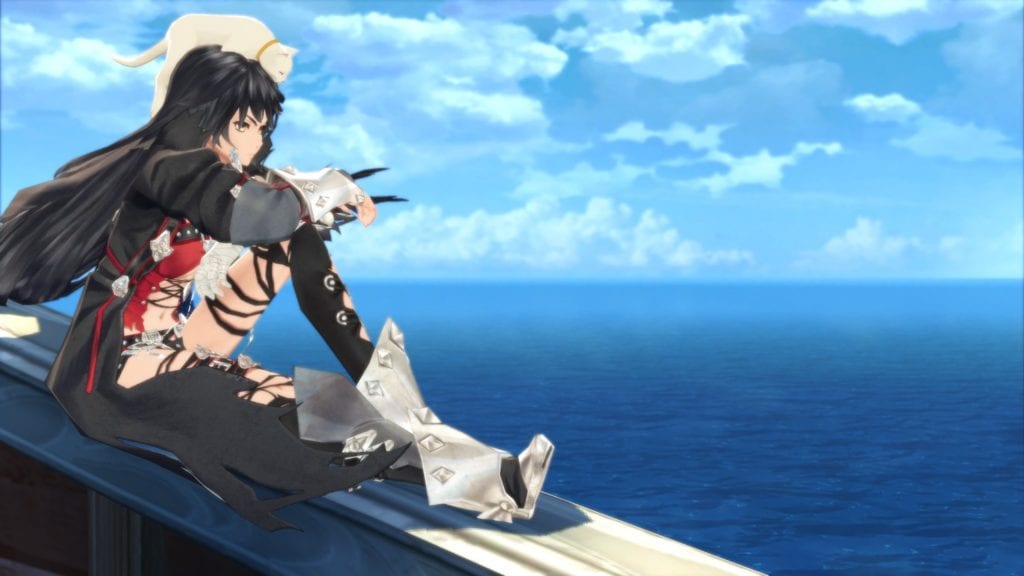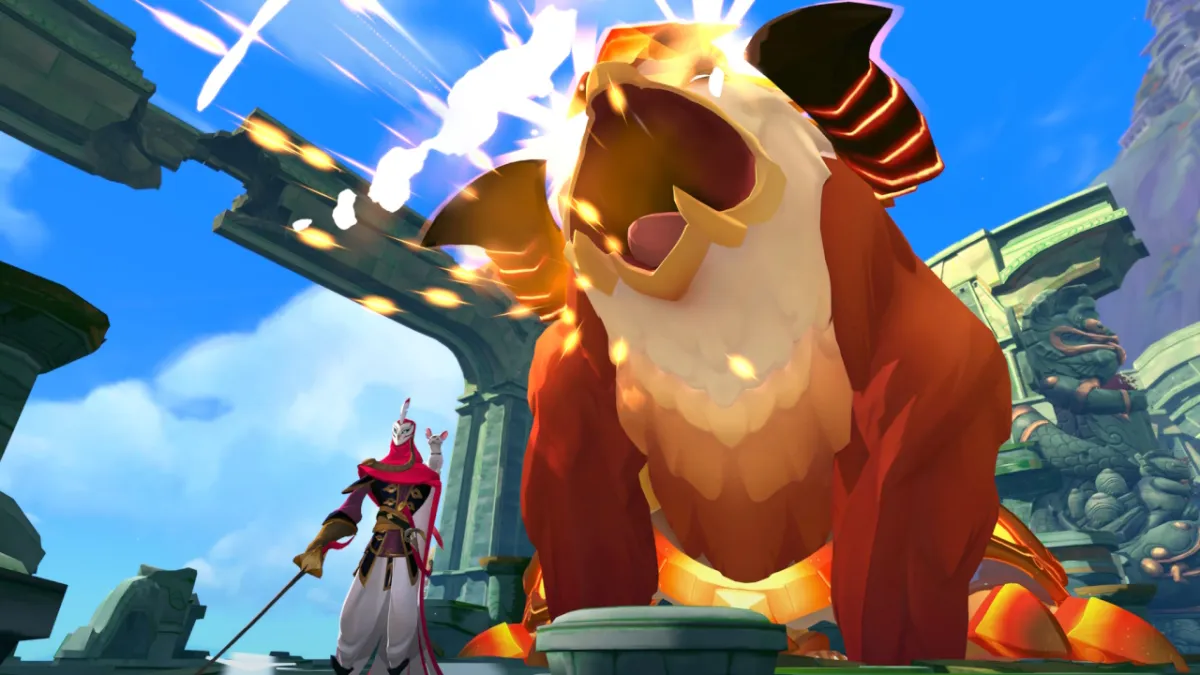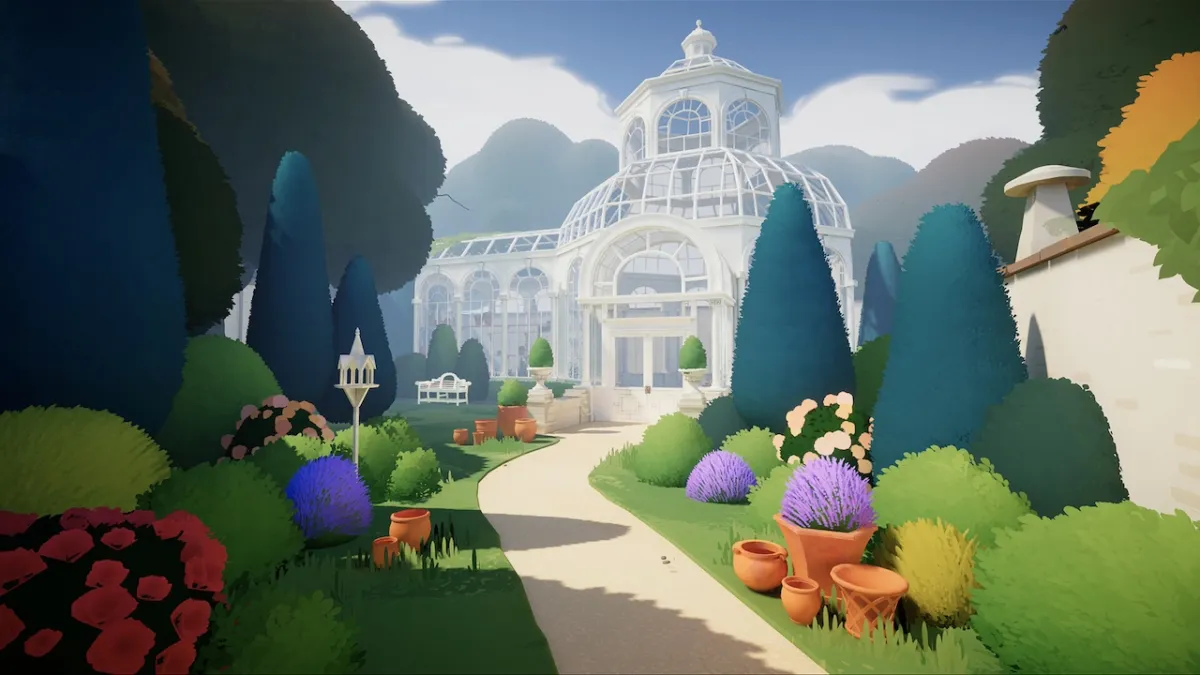I’m done. Nearly 70 hours, but I’m done. Good grief, this took awhile.
Tales of Berseria is a long game, but thankfully, it’s also a good game. Not one that necessarily holds up to 60+ hours of play but a good one nonetheless. Not quite everything I’d hope for from a prominent JRPG, but… good.
Tales of Berseria does quite a lot to flip the genre’s usual story conventions on its head. Yes, okay, your protagonist is from a hometown that gets destroyed in the game’s opening scenes, BUT Velvet Crowe (which would be a really good name for an 80s band) is at best an anti-hero and at worst a villain. She became a daemon with a terrifying monster arm at the time of her town’s destruction, and spent the next three years imprisoned in a hole with nothing to do but nurture her hatred.
That hatred is aimed at Artorius, her brother-in-law. At the time when everything went to shit, he brutally sacrificed her beloved little brother in order to gain the power to save the world from the daemon menace. Three years on and he’s hailed as the world’s saviour, and is the head of a militant church that champions logic over emotions. Killing him won’t be an easy task, and besides the fact that Velvet’s goal will set the entire world against her, succeeding could doom it to destruction. But she doesn’t give much of a shit, and the game’s primary theme is just that: raw emotion versus hard logic.
So, yeah, this is a JRPG in which you’re arguably the villain, and the primary thrust of the plot is trying to track down and murder the great hope of the world. You’re not saving the world. You’re killing the man who saved it.
This doesn’t quite stick. As you probably expect, the Abbey isn’t actually the holiest of organisations, and there are some dark machinations afoot… but the antagonists firmly believe that what they’re doing is right, and from a certain point of view it’s not too hard to sympathise.
Still, it’s rare to get a sense that Velvet and her party are the “good guys”, considering she’s more than happy to sacrifice innocents and destroy livelihoods to make progress. The initial jailbreak characterises this nicely when she incites a riot as a distraction, with the probable deaths of every other prisoner not bothering her one whit as long as it means she can escape. Meanwhile, those other party members include a daemon swordsman who wants to off a family member, a dreaded pirate, a young angel-like creature that you technically kidnap… Even when they’re doing good things, it’s hard to say that this band of villains is anything nobler than that.
This is largely refreshing. Admittedly, Velvet herself either comes from the Squall School of Protagonists or was shot in the face by a phaser set to maximum brood, but this is mostly so the rest of the party can use her as their comic straight man, and her verbal frowning is occasionally punctuated by rage-filled outbursts. That daemon swordsman is a relentlessly cheery fellow, while the dreaded pirate loves going off onto self-satisfied tangents about history and art. And that’s without mentioning the absurdly over-dramatic witch who does her damnedest to troll the rest of the party as hard as is humanly possible. Everyone grows as a character over the course of the game, and I found the whole motley crew to be eminently likeable (although Velvet’s angst does get wearying).
In typical Tales of fashion, these party interactions are highlighted through the Skits function. When wandering the world, you’ll be prompted that a new Skit is available; tap a button, and a little dialogue interlude will ensue. This is normally for humour, though it occasionally displays character growth, relationships, or musings on recent events. These are entirely optional, though, so if you don’t really care about Rokurou and Eizen arguing over who’s the best at fishing, you can safely skip it.
It’s probably clear that I really quite like the plot, the story, and the characters. Some of them are destined to split the fanbase: I enjoyed Magilou’s above-and-beyond dedication to trolling the shit out of the party, but I’m certain others will hate it. Likewise, Velvet’s inability to crack a smile for about 40 hours of gameplay (and her, uh, “interesting” choice in costumes) will doubtless provoke some hate.
Nonetheless, Tales of Berseria takes a pretty different tack than most JRPGs. Your party are not nice people, and for the most part, they’re doing things for entirely self-serving reasons. The central conflict between emotion and reason isn’t one that really has a clear “right” answer (except when taken to ludicrous extremes), and is evocative of Shin Megami Tensei‘s Law and Chaos distinctions. There’s quite a lot going on under the shiny anime veneer, and while it’s not going to spawn a new generation of philosophers, I’m tickled that Berseria tries to do more than just present a party of good guys out to save the world from a bad guy.
Considering how long I’ve spent talking about the story and the characters, you’d be forgiven for thinking this is because there isn’t much to say about the actual gameplay mechanics… but that’s actually not true.
Unlike most JRPGs that don’t start with “Tales of”, Berseria opts out of turn-based monster-punching and instead offers up real-time beat-’em-up combat. Think diet Devil May Cry and you’re not too far off.

Despite being a game built for the PlayStation 3 architecture, Berseria‘s art style means it looks pretty good in motion, and even its stills impress from time to time.
Each of the face buttons on your controller (or your mouse; see the technical review for details on that and the issues that may arise) can be mapped to a string of four different moves which execute in order. Different moves are effective against different enemy types, or have different elemental properties, and you can pause the game mid-battle to adjust the combo chains if you so desire. And, naturally, you can block attacks or dodge out of the way with perfect timing to completely mitigate damage.
The bigger part of it is really how it handles your action point analogues, though. You have up to five of these at any given time, and they limit how far into your combo chains you can go. More are earned in battle by doing things like stunning enemies or inflicting status effects, but you’ll lose them if enemies do the same to you.
Interestingly, your maximum can also be spent to perform Break Souls, powerful techniques that mix things up. Velvet’s, for instance, unleashes her demon arm, giving her a nice shot of instant health and cleansing her of status effects, but also causing her HP to drain away over time. Depending on the enemy she hits, she’ll get a bonus (against armoured enemies, her attack will increase the higher the enemy’s defense) and after performing a combo or dropping to 1HP, she’ll unleash a particularly powerful attack.

Combat can get a little… flashy… but it’s usually not too hard to tell what’s going on, when you’re used to it.
Break Souls heavily shift the way you play each character: taking Velvet as the prime example once again, her combat style is oriented towards heavy aggression and risk/reward. You want to constantly be using Break Souls to maximise your damage, keep your health high, and give yourself a little safety net (as dropping to 1HP will trigger an attack rather than killing you), but this also means you risk spending your Souls far faster than you earn them, and if you drop below the point where you can use a Break Soul then you’re heavily crippled, so judging when and where to go fully beast mode on an enemy is also crucial. Every character has different combos, different Break Souls, and different styles; casters usually need to stand still and charge up spells.
And yes, as that indicates, you only control one character in battle at a time. The other three members of your active party are controlled by the AI (and can be given rough AI orders as to what sort of target they should attack and when they should heal), and it generally does an okay job – although fights against tougher enemies can be a bit irritating when they charge directly into powerful attacks. While you never have full control over everyone, you can swap your controlled character at any time and can give direct orders (forcing someone to cast a heal spell, say) whenever you like.
Another neat touch is that you’re expected to game the difficulty levels, which can also be changed whenever you’re not in combat. “Easy” completely drops out the weakness/resistance system and makes much of the game a cakewalk, while the highest difficulties massively buff the enemy health pools and limit the effects of your healing spells. The flipside is that playing on the higher difficulties can earn you more bonus experience and cash (but only as a bonus, so only if you fight well) as well as offering up better equipment. You’ll only see equipment with particularly high-level skills if you’re playing the late game on the harder difficulties, for instance. This does have the mild downside that you can slap the game on Easy and just button-mash your way through any fight that looks even remotely challenging, but hey, that’s on you.

I do love that the various moves have names like “Harsh Rebuttal.” That seems like an understatement for kicking someone in the face.
Levelling up is much as you’d expect, with experience directly correlating to bigger numbers in combat, although the one twist is with the skill system. Every piece of gear has one learnable skill attached, like +10% effectiveness against certain enemy types, and using that piece of gear often enough causes the character to “learn” that skill, keeping it in effect no matter what they’re using. As such, there’s a trade-off between using crap gear to learn really useful skills, and instantly shifting over to the most powerful kit you have. Gear can also be dismantled and upgraded to up its numbers further or to unlock extra non-learnable skills. It’s not a big system, and nothing quite as game-changing Final Fantasy IX‘s take on equipment skills, but it’s a nice touch.
So why, after all of this, am I still only willing to call Tales of Berseria “good”? There are reasons, although I’ll happily admit that a few of them are entirely subjective.
Firstly, it’s painfully linear. The game regularly uses flimsy excuses to block you off from areas you’re not meant to reach yet, and you’ll only be able to really access most of the side-quests right before the final dungeon. Even when you’re given chances to go and do your own thing, it’s normally only for a very limited time, and starting up the next story segment will railroad you for a few more hours. This focus on the main story has its benefits, but I like being able to dick around and do other stuff when I feel like it. Exploration and meaningful backtracking is something I loved about older JRPGs, and it’s fallen by the wayside a lot lately.

I can’t actually remember if this is a bit of the overworld or a dungeon, and honestly, it barely matters.
Secondly, I miss having a traversable world map. Berseria is set across an archipelago of islands and a menu-driven boat is used to hop between ports, which is fair enough… but the islands themselves have no “overworld”. You’re essentially doing a mini-dungeon to get from one area to the next, and this – again – felt a little limited, not least because one island is apparently a town and a cave system and a mountain with nothing in between. One late-game segment makes a big deal of you crossing an inhospitable waste… which extends for roughly two screens. It feels tiny. On a world map where I could see this, it might’ve been different; it would even have been a decent excuse for an overworld dungeon.
Thirdly, the actual dungeon design is a bit shit, and progress is normally impeding by switch puzzles. They’re occasionally disguised (find a red tree and eat a red fruit to get past the red toxic gas!) but they are, nonetheless, switch puzzles. They are boring and rubbish, and that really is the height of the game’s dungeon design.

Because putting Rokurou in a swimsuit and then giving him an eyepatch and a moustache is something everyone should do. Or putting a cat on Velvet’s head. Or…
All of this drags Berseria down from what could be a spectacular game to one that’s merely good, because I’m not a big fan of spending 60 hours being railroaded into boring dungeons. It’s fortunate, then, that the plot, story, characters, combat, and little extras like an utterly absurd cosmetic system buoy things up enough to make Tales of Berseria still pretty bloody easy to recommend.
I’ll admit, I hoped for more. One of the first times I properly experienced the Tales of series was with the superb Vesperia, which made me feel like I’d suddenly discovered a lost gem of the SNES JRPG era, and I’d hoped for a similar wave of nostalgia and surprise from Berseria – but that’s not the case. Despite not hitting that game’s heights, though, this is still a good action-JRPG. I wish a few things were handled differently, but nonetheless, it’s good. If you like your JRPGs, I suspect you’ll agree.








